April 21, 2017
Air Date: April 21, 2017
FULL SHOW
SEGMENTS

Marching for the Earth and Science
View the page for this story
As Earth Day celebrates its 47th year on April 22 a billion people gather around the globe to celebrate our green planet. Thousands also meet on the National Mall to defend science as well with teach-ins on climate change and scientific literacy. Host Steve Curwood discusses the elements that galvanized this planetary celebration with Earth Day Network President Kathleen Rogers and why this year’s theme is so vital. (07:25)
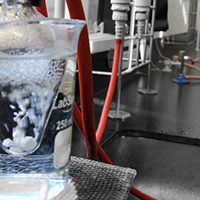
Passing Up the March for Science
View the page for this story
The March for Science recruited students, researchers, professors and other science-enthusiasts from across the country. But some decided to opt out of the event, including Dean Robyn Hannigan of the University of Massachusetts School for the Environment, where Living on Earth is based. Dean Hannigan shared with host Steve Curwood her concerns about the problems and outfalls she sees in a politicized march for science. (06:00)

Lead Safety Budget Cuts
/ Jenni DoeringView the page for this story
Childhood lead poisoning remains a great threat to young children, and even low levels can stunt development and increase the risk of delinquency and crime later in life. State, local, and federal programs aim to reduce lead exposure, but the Trump Administration proposes to cut funding for the Environmental Protection Agency’s lead programs and leave the task to the states. Living on Earth’s Jenni Doering reports. (06:20)
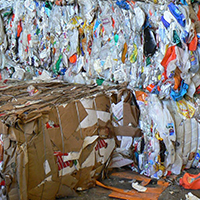
Beyond The Headlines
/ Peter DykstraView the page for this story
Peter Dykstra and Living on Earth Host Steve Curwood discuss stories about international recycling smugglers as well as reports of high-level meetings between the Trump Administration and federally regulated industry executives who want rules changed. Then they look back 50 years, when the ugly but majestic California Condor almost flew its last wild flight. (02:50)

Science Note: Ant First Aid
/ Kit NortonView the page for this story
Researchers from the University of Wurzburg in Germany have discovered that ants in Sub-Saharan Africa are carrying their wounded back to their nest to recover after hunting raids on termites, as Kit Norton explains in today’s Note on Emerging science. (01:40)
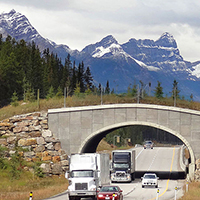
How to Save Most Species
View the page for this story
Within decades Earth may lose as many as 50% of the species currently living on our planet. To avert ecological disaster, renowned conservationist and Harvard Professor E.O. Wilson has proposed a radical idea in his book Half-Earth: to set aside half of Earth’s land and sea for nature. He believes that this could save 80% of the species and preserve ecosystems. Host Steve Curwood spoke with E.O. Wilson to learn why the 87-year-old ecologist is optimistic about the role of technology to help with this mission. (20:00)

We Are All In This Together
View the page for this story
To honor Earth Day’s 47th birthday, host Steve Curwood recalls how the first sight of our small, fragile blue planet from space gave urgency to the push to fight for conservation and against widespread pollution, and helped launch a movement. And he notes, despite many environmental gains, serious threats remain that we have to resolve together. (02:00)
Show Credits and Funders
Show Transcript
HOST: Steve Curwood
GUESTS: Kathleen Rogers, Robyn Hannigan, E.O. Wilson
REPORTERS: Jenni Doering, Kit Norton, Peter Dykstra
[THEME]
CURWOOD: From Public Radio International, this is Living on Earth.
[THEME]
CURWOOD: I'm Steve Curwood. On Earth Day 2017, a billion people around the globe plan to turn out to celebrate and clean up the planet.
ROGERS: We are going like gangbusters in China and India, ordinary citizens from the developing world, turning out like Americans did in 1970. We plant trees, we clean up garbage, we march, we protest, we challenge our government. I don't know where the world would be without Earth Day.
CURWOOD: Also, the continuing scourge of lead paint.
PALFREY: The lead is acting in terrible ways on children’s minds and bodies. And the only way we can prevent school failures caused by lead, or job failures, or crime is to prevent lead poisoning in the first place.
CURWOOD: But President Trump wants to cut funds to remedy this toxic legacy. That and more, this week on Living on Earth. Stick around.
[NEWSBREAK MUSIC: Boards Of Canada “Zoetrope” from “In A Beautiful Place Out In The Country” (Warp Records 2000)]
[THEME]
Marching for the Earth and Science
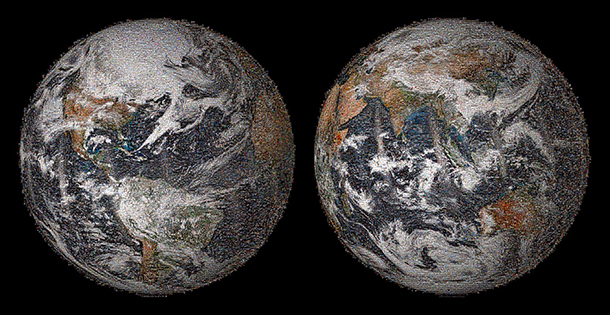
For Earth Day 2014, NASA pasted together a global “selfie” of the earth comprised of photos that people from around the world had posted on Earth Day. (Photo: NASA, Wikimedia Commons public domain)
CURWOOD: From PRI, and the Jennifer and Ted Stanley Studios at the University of Massachusetts Boston, this is Living on Earth. I’m Steve Curwood.
[MUSIC: The Beatles "Let it Be” on Let It Be, written by Paul McCartney, Apple Records]
CURWOOD: On April 22, 1970, the Beatles "Let It Be" was number one on the record charts as some 20 million Americans gathered for the very first Earth Day. Cities from New York to Los Angeles were choking in smog, and Cleveland’s downtown river had caught fire several times, the pictures getting national notoriety in Time magazine, along with the first color photos of Earth taken from space. So, people marched to let nature be, and by the end of the year Republican President Richard Nixon had created the Environmental Protection Agency and signed the Clean Air Act.
Today, some 47 years later, thousands of concerned citizens celebrate Earth Day by taking to the streets, coordinating this year with a March for Science. Kathleen Rogers is the president of Earth Day Network, and she joins us now.
Welcome to Living on Earth.

The poster from the original Earth Week, in 1970. (Photo: Peter54321, Wikimedia Commons CC BY-SA 3.0)
ROGERS: Thank you very much, I’m happy to be part of the show.
CURWOOD: And now Earth Day is 47 years old. How's it doing?
ROGERS: It's doing wonderfully. We have over a billion people participating worldwide. We are going like gangbusters in China and India. It is incredibly rewarding to see ordinary citizens from the developing world turning out like Americans did in 1970. We plant trees, we clean up garbage, we march, we protest, we challenge our government. I don't know where the world would be without Earth Day.
CURWOOD: Tell me about the theme of Earth Day this year. Why it important?
ROGERS: Our theme this year is global climate, environment and science literacy. We have begun to see, partially based on the Paris climate Agreement that we need to create an educated workforce if we're going to build a green economy. If we're going to build a consumer base for green products, if we're going to educate scientists for the future, we need to educate people about not just the facts of the environment but also helping them internalize the values and then put it in the context of jobs and growth. In United States, we literally have 50 different environmental literacy plans for each one of our states. Our goal is to create a unified approach to environment and climate science, promoting not just the information and not just the values but also the potential for America to lead in the green economy.
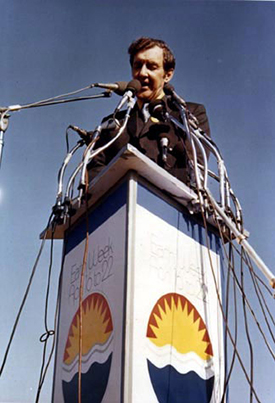
Senator Edmund Muskie, author of the Clean Air Act of 1970, addressed a crowd in Philadelphia on the first Earth Day in that same year. (Photo: Peter 54321, Wikimedia Commons CC BY-SA 3.0)
CURWOOD: So, April 22 in the United States this year is also the date of the March for Science. Who did you expect was going to show up at the Saturday event on the National Mall?
ROGERS: Well, we had originally just been focused on creating teach-ins on the National Mall, but when we partnered with the young scientists from March for Science, we began to see great interest not just from the scientists but also many demographics. So, we have faith-based groups that are attending, environmental groups. There’s just an extraordinary array of community groups also joining the March for Science. So, I would say it is truly representative of the US population, and, while perhaps won't dominated by white lab coats, we do expect many, many scientists to be on the Mall.
CURWOOD: Why is it important for scientists to stand up, to participate in this demonstration in the face of political opposition to their work?
ROGERS: You know, their integrity has been brought into question, and scientists spend years and years in labs away from public view, and now they're coming out of their labs, out of their federal agencies, and they're going to march because for that reason and that reason alone. I think more than anything they believe that there is a set of facts, there is such a thing as truth, and there is such a thing as integrity, and all of those things have been questioned and that's why they're marching.
CURWOOD: Now, what about concerns? Some criticize this as saying that science is being politicized, giving it a left-wing tilt. How do you respond to criticism that the scientists are letting themselves get caught up in politicization?
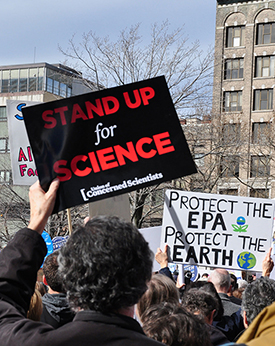
Demonstrators at the Boston “Stand Up for Science” Rally on February 19, 2017 waved a variety of signs signaling their stance against what they saw as President Trump’s anti-science agenda. (Photo: AnubisAbyss, Flickr CC BY-NC-ND 2.0)
ROGERS: Well, I mean, all human beings are political. Scientists vote just like you and I do. They have their own views of the world, and so asking them to remain away from view, asking them not to take a position on any subject including their own integrity I think is asking a bit too much. They have been inundated with the news about the alternative view of the universe, alternative facts, and at a certain point they needed to march. They needed to come out into the sunlight and talk about their work and talk about how important it is and how there are a set of facts. There are values. There is scientific truth, and all of those things don't necessarily mean or have anything to do with politicization of anything. Politics is very different, partisanship is very different, and the scientists aren't there to be either one of those things. They're there to defend themselves, defend their jobs, defend their research, and be part of a movement that I think is taking place nationwide, and that is there are critical things on Earth - those sets of values that Americans believe deeply in - and they cannot be questioned as part of the fabric, part of the DNA of America. And they want to share in those values and they want to share in that process.
CURWOOD: So, April 22, Earth Day, March for Science. What happens next?
ROGERS: The March for Science begins a weeklong of climate education worldwide. We are also the bookend. The People's Climate March is the following Saturday on the 29th, and so we are part of a process, I think, of bringing people together to the streets, coffee houses, online, in a conversation about the things that really matter, and I think you're seeing a larger more committed constituency for becoming engaged in public policy. Not just scientists, but the environmental community, the food and drug scientists of the world. Everybody seems to want to be engaged in the conversation, so it's a beginning of a long process, but it's fun that the Earth Day Network is kicking off this weeklong set of activities around climate education and science in general.

Kathleen Rogers is the President of Earth Day Network (Photo: Earth Day Network)
CURWOOD: Now, historically the environmental movement in the US has been largely a white and middle-class movement. And, Kathleen, I believe we last spoke in 2008.
ROGERS: We did.
CURWOOD: And Earth Day Network was focusing its efforts on reaching a more diverse audience What do you have to report in terms of progress on that front?
ROGERS: Well, I think that's the question. Membership of the environmental community continues to be less diverse than we hoped it would be, but there are environmental groups, there's social justice and environmental justice groups springing up all over the country. So, from that perspective we're seeing a huge movement at the local level, which is where we think the action should be because whether you're siting a power plant or you're siting a transmission lines or you're opening a coal mine or whatever else you're doing, we need local constituents who are fully engaged and who represent that, not just a single demographic, but all of America. So, while it's been slow, the environmental community continues to invest, not just in itself to build a diverse movement, but also in local communities and certainly on our stage we're going to be bringing together a large group of diverse scientists from around the world and community groups that can speak to that issue.
CURWOOD: Kathleen Rogers is the President of Earth Day Network. Thanks so much, Kathleen.
ROGERS: Thank you for having me.
Related links:
- March for Science home page
- Earth Day Network home page
- Our 2008 interview with Kathleen Rogers about diversity and Earth Day celebration
Passing Up the March for Science
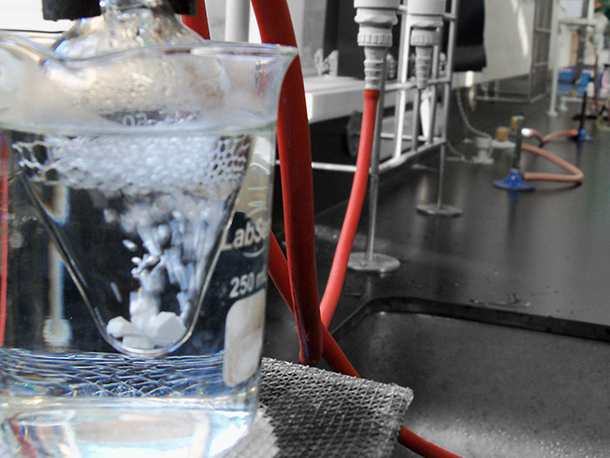
One objection to the March for Science is that it mixes science and politics in a way that confuses rather than clarifies the role of science in society. (Photo: Kiran Foster, Flickr CC BY 2.0)
CURWOOD: We’ve just heard Kathleen Rogers of the Earth Day Network describe why this year’s Earth Day celebration is combined with a March for Science, but not everyone is impressed with that notion. For a different perspective we turn now to “Green Dean,” Robyn Hannigan. She’s the Dean of the School for the Environment at the University of Massachusetts, Boston, the home of Living on Earth.
Welcome, Robyn.
HANNIGAN: Thanks, Steve. Thanks for having me.
CURWOOD: So, Robin, talk to us about your background. You're a scientist. What brought you into this field?
HANNIGAN: So, I grew up in Narragansett, in Rhode Island, and what brought me in was a graduate student at the University of Rhode Island. She was doing her PhD in the early 1970s, and she let me, when I was a little kid, collect mussels and barnacles for her research. I came from a low-income background, mixed heritage. College was not an option. I would be lucky to get through high school, and had it not been for that grad student turning me on to the possibilities of science, I never would have gone to college, let alone get a PhD.
CURWOOD: So, I understand you don't think scientists marching in protest is such a great idea. Why?
HANNIGAN: Well, that's a broad swath of what I think. I believe that politicizing science is a difficult thing, is a complex thing, and I don't necessarily want to see science, which is simply a way of knowing about our planet and ourselves, politicized in a way that doesn't actually change anything.
CURWOOD: I think people are concerned that scientists are getting fired at the EPA, that the scientific budget is getting slashed. That's what they want. They would like to have things go forward.
HANNIGAN: So, I think in that case you're not marching for science, you're marching for the support of federal science, and that requires that we step up and do what other countries have done, and that is change the constitution and amend it so that our planet itself has some rights. That, I could get behind marching for.
CURWOOD: So, why do you think people are, in fact, organizing to march for science? What's the catalyst? Why weren't we doing this before?
HANNIGAN: I think the catalyst now is that you do have an administration that appears to be more proactive in changing the way in which science is used to inform decision-making, and I think that that brings forward a concern. The fact that we haven't been present before is more alarming to me, that we haven't in the past several decades stood up and been counted, that we haven't been a stronger voice in the federal and the state legislature in the towns and the municipalities, in the school systems. All you're seeing today is a reflection of the fact that we've been sitting down and being absent for the past 20 to 30 years.
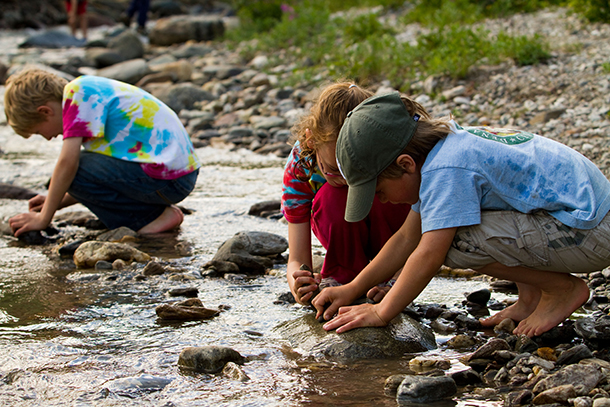
Dean Hannigan advocates for changes in science education. (Photo: Denali National Park and Preserve, Flickr CC BY-2.0)
CURWOOD: What are some the signs of being absent from the science discussion over the past 20 or 30 years? What are the issues, the scientific approaches that we've missed from your perspective?
HANNIGAN: Well, the renewable energy sector, I think. There were certainly scientists and engineers calling for the fact that renewable energy was an opportunity both for economic development, for scientific discovery, and we worked very closely with industry to advance that sector, but we didn't engage in the decision-making process. We weren't engaged in our municipal and our state and our federal legislatures in a way that engendered confidence and that engendered the funding necessary to expand that sector. So, we relied very much on our private industry partners, which was at the time the only option, but had we been standing up for science all along we might've been inserted in the conversation earlier which would've engendered funding for that sort of research and changed the trajectory that we're currently on.
CURWOOD: At what point do you think scientists have to become activists? What kinds of risks do you think scientists should warn the public about beyond the publishing and teaching?
HANNIGAN: I think if we genuinely see an erosion of regulations to protect human health, then I think we need to stand up, and we need to fight. I think if we see a change in the standards by which we teach K-12 and an elimination of science as one of disciplines that we center on, then we stand up, and we fight. Right now, I think we need to be more informed and more engaged at the local level to prevent those things from happening.
CURWOOD: Now to what extent do your concerns about the March for Science, the Earth Day March for Science reflect a concern that you think that science might get identified with one part of the political spectrum or the other?
HANNIGAN: Well, I mean, I think because it's a response to what's happening in our current administration, it's easy to politicize it and say, “Well, you know this a liberal, elite response to what's going on in the conservative party.” My biggest concern is that you're going to have this turnout of scientists and people who are concerned about science on Earth Day and then they're all going to go away. They're not going to stay engaged. There's no legislative action that going to be following this, so I don't know if you can sustain the momentum of something that I think is critically important.
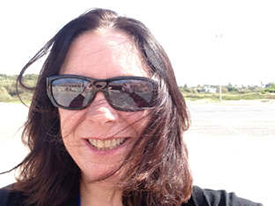
Geochemist Robyn Hannigan is Dean of the School for the Environment at the University of Massachusetts, Boston. (Photo: Robyn Hannigan)
CURWOOD: So, to be clear. If you were the president's science advisor right now, you would be telling him to put back all those scientists that they want to cut at these various agencies and then what more would you tell them?
HANNIGAN: Well, I don't know that I would say put them all back. You need to have a much more considerate and thoughtful conversation about that, but I think that I would definitely say that the things that resonate, what appear to resonate at least with this current administration is economic growth, economic development and opportunity, a fair voice and a fair share, and all of those things will be fostered by a strong science and technology education and research and development cluster, and so, by disinvesting in science, that you might politically disagree with, you're also losing all of the value adds science that comes along. I think if you just look at NASA and what the space race did for science in general. A lot of the things that came out of that space race has nothing to do with what was going on in terms of space travel but genuinely impacted people's lives both in terms of medicine and technology. So, I would encourage the current administration to be more thoughtful about where they do invest in science and technology, but to not disinvest. It would be foolish.
CURWOOD: Robyn Hannigan is the Dean of the School for the Environment at the University of Massachusetts, Boston. Thanks so much for taking the time with us today, Robyn.
HANNIGAN: Thanks, Steve.
Related links:
- New York Times: “The March for Science: Why Some Are Going, and Some Will Sit Out”
- About the March for Science
- Robyn Hannigan Faculty Profile
[MUSIC: Nino Rota, “La Bella Malinconica (“The Beautiful Melancholy” from the film La Dolce Vita), on Arriverderci Italy, Sony Music]
CURWOOD: Coming up...it’s soft, malleable, dense, and deadly. Lead and its costly legacy. Stay tuned to Living on Earth.
ANNOUNCER: Support for Living on Earth comes from the Gordon and Betty Moore Foundation, and from a friend of Sailors for the Sea, working with boaters to restore ocean health.
[CUTAWAY MUSIC: Nino Rota, “La Bella Malinconica (“The Beautiful Melancholy” from the film La Dolce Vita), on Arriverderci Italy, Sony Music]
Lead Safety Budget Cuts

Kids frequently put their fingers in their mouths – and if they’ve just been touching lead dust, which frequently happens in old homes with lead paint, they can ingest lead. (Photo: Andrea Kirkby, Flickr CC BY-SA 2.0)
CURWOOD: It’s Living on Earth, I’m Steve Curwood. In over a fifth of American homes, according to the Department of Housing and Urban Development, the presence of old lead-based paint creates a hazard to young children, whose developing brains can be harmed by even low levels of the toxic heavy metal. In light of these public health risks, the Environmental Protection Agency has special programs focused on reducing lead exposure in homes. But these are among many EPA programs on the chopping block in President Trump’s proposed budget.
Living on Earth’s Jenni Doering has more.
DOERING: First, the good news: Overall, childhood lead exposure is a success story, says pediatrician Sean Palfrey.
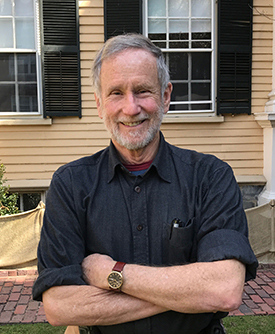
Sean Palfrey, MD (Photo: Jenni Doering)
PALFREY: We’ve come a huge distance in terms of getting the rates of lead poisoning, serious lead poisoning, down.
DOERING: Dr. Palfrey has run lead poisoning prevention programs in Massachusetts since the 1970s. The Bay State has been a leader in reducing childhood lead exposure.
PALFREY: Still, we have thousands of children who have lead levels of over five, which is the designated CDC level of concern, so that we are constantly finding children who are poisoned at low levels.
DOERING: That’s five micrograms of lead per deciliter of blood, the typical way to measure lead in the body. Nationally, the numbers are similar. Less than three percent of kids today have excess blood lead. Back in the year 2000, nearly nine percent of kids had elevated levels of the toxic heavy metal.
REYES: It’s bad for everyone at every age. It’s particularly bad for kids whose brains are developing.
DOERING: Jessica Reyes is a professor of Economics at Amherst College.
REYES: My work looks at the impacts of early-childhood lead exposure at general population levels on things like violent crime, child behavior problems, teen pregnancy, bullying, substance abuse.

Leaded gasoline was available to American consumers until 1996, although the EPA had already orchestrated the phase-out of the majority of leaded gasoline by the late 1980s. (Photo: Steve Snodgrass, Flickr CC BY 2.0)
DOERING: Professor Reyes studies the societal effects of moderately elevated lead levels in young kid, five to 10 micrograms per deciliter.
REYES: And at those levels I find substantial effects on child behavior problems and teen pregnancy and crime, to the extent where if you change lead by, say, 10 percent, you will get later a change in crime of about 7 or 8 percent. And my estimates are that a third to half of the decline in crime that occurred in the 1990s could be attributed to the removal of lead from gasoline in the 1970s.
DOERING: Rising concerns over lead poisoning in the early 1970s prompted national testing. Dr. Palfrey again.
PALFREY: Once we started testing, we found that everybody was lead poisoned in certain parts of the country along the east coast, along the middle-west.
DOERING: Back then everyone in America was breathing in lead in the air from car exhaust, but some young kids were getting a higher dose from ingesting dust and chips from degraded paint. In 1922 the League of Nations with its nearly fifty countries banned the household use of lead paint. But the U.S. never joined the League, and Congress did not enact a similar ban until 1978. The U.S. EPA phased out leaded gasoline through the 1980s. But even today some 38 million homes still have remnants of lead paint, and the risks posed by lead dust increase during home renovation.

Home renovation projects can spread dangerous lead dust through a home if proper precautions aren’t taken. (Photo: Alan Bruce, Flickr CC BY 2.0)
PALFREY: One of the things we talk to parents about is the danger of renovating your house with your child in it. Because, in the process of renovation, you stir up the lead in the paint and it gets in the dust, you inhale it, the children inhale it, they get it on their hands they put their hands in their mouth.
DOERING: Yet despite millions being at risk, government programs aren’t always effective. The Chicago Tribune recently reported that the local Housing Authority failed to thoroughly inspect subsidized rental homes with young kids, but declared them safe anyway. Dozens of children were diagnosed with lead poisoning. Dr. Palfrey says we need to do better.
PALFREY: The lead is acting in terrible ways on children’s minds and bodies for decades. And the only way we can prevent school failures caused by lead, or job failures, or crime, or educational deficiencies, is to prevent lead poisoning in the first place.
DOERING: But at the national level there is uncertainty about funding for prevention. President Trump’s budget blueprint calls for a nearly $17 billion cut in federal spending on EPA’s lead risk reduction programs and for states to take responsibility (ERROR- the correct figure is nearly $17 million-editor). Jessica Reyes is skeptical that this will work.
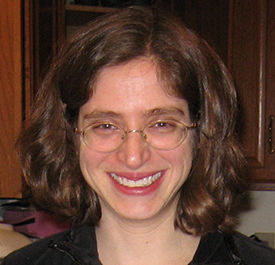
Professor Jessica Reyes (Photo: Amherst College)
REYES: I am pretty sure that when the federal government stops funding this, there will just be a lot less funding for it. It is not going to win the battle in state legislatures even, I think, in progressive states.
DOERING: But industry welcomes the move. In early April the Washington Post reported that the CEO of the National Association of the Remodeling Industry, Fred Ulreich, stated that his group “believes that the program can be better run and enforcement can be more vigorous the closer it is to the local contractors.” We asked for further comment from the Association, but they declined. Meanwhile, Dr. Sean Palfrey is worried.
PALFREY: The proposition that we cut EPA funding to states for lead poisoning prevention is very shortsighted and doesn’t acknowledge the fact that prevention is where we need to be at this point. And, if we defund the ability to do that, then we are enabling, allowing, the poisoning of most of our children.
DOERING: An EPA spokesperson stated, in part, “EPA is evaluating different approaches to implementing the President’s budget that would allow us to effectively serve the taxpayers and protect the environment.”

Restoration work on the U.S. Capitol rotunda last year involved removing hazardous materials, including lead paint. (Photo: US Capitol, Wikimedia Commons public domain)
Regardless of funding, Sean Palfrey and Jessica Reyes continue to work to prevent lead poisoning in children. Dr. Palfrey advises parents on how to get rid of lead in their homes and says that for kids who do have elevated lead levels, reading to them, playing with them, and enriching their environment is the best way to counteract its effects.
For Living on Earth, I’m Jenni Doering.
Related links:
- EPA: “Protect Your Family from Exposures to Lead”
- President Trump’s “America First” budget blueprint
- Washington Post: “Trump’s EPA moves to dismantle programs that protect kids from lead paint”
- Chicago Tribune: “Kids poisoned by lead in CHA housing; landlords still got paid”
- EPA’s Renovation, Repair and Painting Program
- About Sean Palfrey, MD
- About Jessica Reyes, PhD
- The National Association of the Remodeling Industry
[MUSIC: Louis Lortis, “Gaspard de la nuit: I. Ondine” on Louis Lortie Plays Ravel’s Complete Works for Solo Piano, written by Maurice Ravel, Chandos Classics]
Beyond The Headlines

Bales of plastic stored at Pier 96 in San Francisco. California’s relatively generous payments for container recycling tempted Balmore Alvarado and Anthony Sanchez to allegedly smuggle empty plastic bottles and cans from Mexico into the state. (Photo: Walter Parenteau, Flickr CC BY-NC-ND 2.0)
CURWOOD: Time now to join Peter Dykstra of DailyClimate.org and Environmental Health News, that’s EHN.org to go beyond the headlines. Peter’s on the line from Atlanta. Hey, how are you doing?
DYKSTRA: Hi, Steve, doing pretty well. You know, there’s no better way to show your devotion to Mother Earth than through diligent recycling of cans, bottles, and other reusasbles.
CURWOOD: OK, but I have kind of got a feeling there’s a catch here.
DYKSTRA: Oh, yeah. In fact, two men were caught. Baldimore Alvarado and Anthony Sanchez allegedly drove two tractor-trailers from Mexico, through Arizona, to a recycling station in Blythe, California, with $20,000 in recyclables on board.
CURWOOD: That’s a lot of beer and soda cans, and driving two trucks from Mexico to California via Arizona doesn’t sound like they were keen on saving energy.
DYKSTRA: Yeah, it’s several hundred miles to Southern California. The two were charged with felony recycling fraud, attempted grand theft, filing a false or forged document, and conspiracy. No word on how big a sentence they would get if they were found guilty.

Oil rigs drill off the coast of Galveston, Texas. The Trump Administration invited industries working under environmental regulations for discussions at the White House within days of taking office. BP, among other firms, advocated easing the process for leasing patches of the Gulf of Mexico. (Photo: IIP Photo Archive, Flickr CC BY-NC 2.0)
CURWOOD: And what do you have next for us?
DYKSTRA: Well, inevitably we go to Washington, DC, where only days after taking office, the Trump Administration invited the industries regulated by the feds for advice on how to re-make some rules. According to the Washington Post, Industry suggested easing the process for leasing patches of the Gulf of Mexico for oil drilling.
CURWOOD: Hmm, and who wished for that?
DYKSTRA: Well BP, of course. And the US Chamber of Commerce asked that the Labor Department no longer require the posting of injury records on the internet. But more than half of the 168 comments from industry groups and trade associations concerned EPA.
CURWOOD: Sounds like EPA was the center of the bulls-eye there, huh?
DYKSTRA: I think so.
CURWOOD: Peter, let’s take our weekly tour through environmental history now.
DYKSTRA: Well, Steve, 50 years ago this week, wildlife specialists captured the last California Condor alive in the wild. Code-named AC-9, this big, ugly, graceful bird joined others in captivity for an intensive, 20-year captive breeding program.
CURWOOD: From what I can recall, it was a successful captive breeding program.
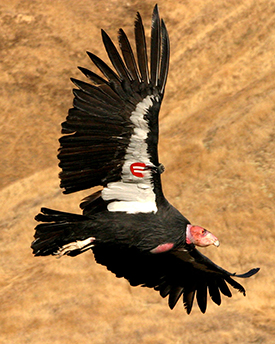
A California condor flies over the Bitter Creek National Wildlife Refuge in 2011. 50 years ago, only one of these birds survived in the wild, but thanks to a captive breeding program, wild condors now number around 200, with another 200 in captivity. (Photo: Pacific Southwest Region USFWS, Flickr CC BY 2.0)
DYKSTRA: Yes, indeed it was. There are now over 400 California Condors, half of them released to the wild.
CURWOOD: So what caused the near-disappearance of this big bird?
DYKSTRA: Well, there were several things. Habitat loss, DDT and ingesting lead shot, those were the main culprits. But now, a hand-made restoration of these huge birds looks like it’s saving a species.
CURWOOD: Yeah, even if that species is only a kind of vulture. You know they still though look magnificent when they’re flying.
DYKSTRA: And kind of ugly.
CURWOOD: [CHUCKLES] Peter Dykstra is with DailyClimate.org and EHN.org. Thanks, Peter. We’ll talk to you again real soon.
DYKSTRA: OK, Steve. Thank you. Talk to you soon.
CURWOOD: And there’s more on all these stories at our website, LOE.org.
Related links:
- Atlanta Journal-Constitution: “Men smuggle $20,000 in empty bottles for California refund, officials say”
- Washington Post: “EPA emerges as major target after Trump solicits policy advice from industry”
- Friends of California Condors Wild and Free
[MUSIC: Simon and Garfunkel, “El Condor Pasa” on Bridge Over Troubled Water, composed by Daniel Alomía Robles, Columbia Records]
Science Note: Ant First Aid
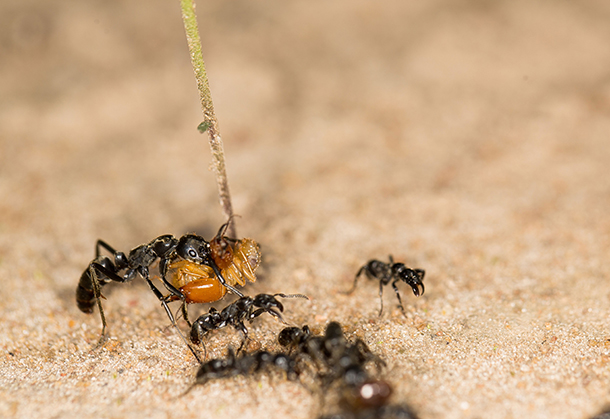
A Megaponera analis “major” carries termite soldiers back to nest, with “minors” walking next to it. After carrying their kill back to the colony, ants return to collect their wounded. (Photo: ETF89, Wikimedia Commons CC BY-SA 4.0)
CURWOOD: Coming up, a modest proposal from one of the world’s most famous ant biologists. But first this note on emerging science from Kit Norton.
[SCIENCE NOTE THEME]
NORTON: When you think of med-evacs and triage, you probably picture some catastrophic accident. But new research has discovered that ants in Sub Saharan Africa are using similar techniques when they hunt termites.
When termites are out foraging, the termite-hunting ant, Megaponera analis, will attack the warrior caste protecting the foragers. As casualties mount on each side, with ants limping with missing limbs, and termites lying dead, the carnivorous ants collect the termites to take back to the nest.
However, they don’t leave their wounded behind. They also carry injured ants back to the colony to heal. According to the researchers from the University of Würzburg, in Germany this is just another move in what they call the “evolutionary arms race between ants and termites.” And this med-evac behavior is paying off as it has reduced ant combat mortality to nearly zero.
Researchers believe that this behavior is triggered by the pheromones dimethyl and trisulphide in the saliva gland inside the lower jaw of the ant. Between the rescue behavior that returns about as many ants to the colony as are born each day and the recovery of the injured, these ant nests typically see about a 29 percent growth in colony size. So this evolutionary behavior benefits both the individual ant and the entire colony.
That being said, it doesn't help the termites.
That’s this week’s note on Emerging Science. I’m Kit Norton.
Related link:
Science Magazine: “Saving the injured: Rescue behavior in the termite-hunting ant Megaponera analis”
[SCIENCE NOTE THEME]
How to Save Most Species

Above, a wildlife bridge helps critters safely cross the Trans-Canada Highway near Banff, so that their habitats are connected. E.O. Wilson calls for an extensive, connected network of ecosystems to be reserved for nature in North America – he calls it, “Squaring America.” (Photo: WikiPedant, Wikimedia Commons public domain)
CURWOOD: A bold new proposal to stem global species’ loss has been created by one of the world’s top experts in ants.
WILSON: Edward, middle initial “O” Wilson, honorary curator of insects at the museum at Harvard.
CURWOOD: E.O. Wilson, as he’s commonly known, has won two Pulitzer prizes, including one for his book on ants. But the distinguished Harvard biologist has been studying the challenge of species loss for years, focusing on unique habitats that should be conserved to protect the diverse ecological webs within them.
Now in his book "Half-Earth," he has done the math. He says we can preserve the bulk of species and ecosystems if we set aside half of the Earth’s surface, both land and sea. I spoke with Professor Wilson at his home in Lexington, Massachusetts, and he explained why many ideas for how to tend to Nature are, well, misguided.
WILSON: I’m concerned because those that I like to call the “Anthropocenists,” that is, those who feel humanity has so thoroughly changed the surface of the Earth and the seas as well, that we might as well give up. The Anthropocene, carried to an extreme in its conception is that we've lost the battle in terms of saving natural areas, even in terms of saving most of the biodiversity, the variety of life left on Earth, so we should follow along now in the next stage either one, to just let it go, and proceed to humanize the entire globe. Maybe that’s the destiny of the planet. The second version of Anthropocene enthusiasm is, “Don't worry, the species that have gone extinct. If we keep specimens of them, we'll keep their DNA, and we'll find out a way to clone them, and we'll put them all back eventually and recreate natural ecosystems”. All these and similar schemes that have been suggested, relatively the same in my view, is running up the white flag as soon as you see the pennants of the enemy appearing on the horizon.
CURWOOD: So we can do better, you think.
WILSON: We better do better! Yes, we can do vastly better, and the conservation movement around the world has been doing everything possible in a conventional worldview with nobility of purpose, with enormous energy and effort and dedication. It's saved a lot of species.
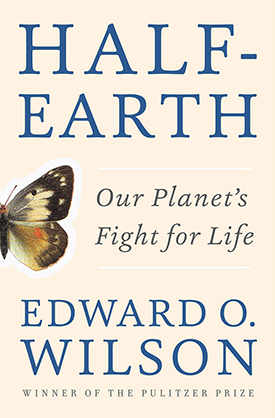
E.O. Wilson’s latest book is Half-Earth: Our Planet’s Fight for Life. (Photo: W.W. Norton)
But what most people don't realize is that in addition to those beautiful big animals that we so admire and we see going extinct or up to the brink of extinction, there are literally millions of smaller creatures that are the foundations of our ecosystem both on the land and the sea, and that they, too, are probably disappearing at about the same rate. So that we simply are not doing enough for the vertebrates. That's the group we know the best because we know all of the vertebrates. We know the fish, we know the amphibeans, and we know the birds and mammals and reptiles. One-fifth of those vertebrate animals I just listed are sliding down at a pretty rapid rate and going off the cliff to extinction, and of that one-fifth we're losing, even with our best efforts, 80 percent or so.
We haven't stopped it. We've slowed it, but we haven't stopped it. So, we needed something completely different.
CURWOOD: And the bottom line? Of course, we're talking about your book "Half-Earth: Our Planet's Fight for Life".
WILSON: Yes, the book's premise is that what we need to do is try for a moonshot, and the moonshot is to set aside half the surface of the land and half the surface of the sea as a reserve, a reserve that doesn't exclude people by any means - Indigenous people are, in fact, encouraged to enjoy them and continue their way of life - but, if we could give half of the Earth primarily to the millions of other species that inhabit the Earth with us, then we would be able to save about 80 to 90 percent of the species, bring the extinction level down what it was before the coming of humanity. That would be a successful moonshot.
CURWOOD: So, talk to me with some math about the concept of Half-Earth. Just how could this work? How would this work?
WILSON: So, where are we right now? And I can tell you that, in the United States, we have already put aside about 15 percent of the land surface, and, for the planet as a whole, this is land. We're about the same. We are at about a 15 percent mark around the world for the land. And for the sea it is far less, somewhere about one to three percent, and in the United States it’s up towards what it is for the land. It's about 10 percent of the territorial waters of the United States. So, we need to move that on up to about half in order to reach a fairly safe level.

Host Steve Curwood interviews E.O. Wilson at the ecologist’s home in Lexington, MA. (Photo: Jenni Doering)
Can we do it? Yes, we can do it. Just taking opportunities, gerrymandering small pieces, linking existing parks and small reserves together, we can move the United States up to 50 percent.
[MUSIC: Morgan Matthews & Radio Paint “Motion,” not commercially available]
CURWOOD: That’s biologist and conservationist EO Wilson. When we return, he describes how we might help create the protected wild space he advocates by linking North America’s natural spaces together.
WILSON: I have a notion I call “squaring America”.
CURWOOD: That’s just ahead here on Living on Earth. Stay tuned.
ANNOUNCER: Funding for Living on Earth comes from you our listeners, and United Technologies - combining passion for science with engineering to create solutions designed for sustainability in the aerospace, food refrigeration and building industries. UTC companies such as Otis, Carrier, Pratt & Whitney and UTC Aerospace Systems are helping to move the world forward.
This is PRI, Public Radio International.
[CUTAWAY MUSIC: Morgan Matthews & Radio Paint “Motion,” not commercially available]
CURWOOD: It’s Living on Earth, I’m Steve Curwood. We’re back now with renowned conservationist E.O. Wilson, whose recent book "Half-Earth" proposes a daring idea. He says we need to set aside half of the Earth’s land and sea for the 10 million other known species on the planet. To reach that ambitious goal, Professor Wilson imagined how we might conserve so much North American land.
WILSON: I have a notion I call "squaring America”, North America, including the United States. We start Yukon to Yellowstone. That can be done right now, but let's go on. Yellowstone on down to the Rocky Mountains, and we could easily, well relatively easily, set up reserves all the way down there as a continuation of the corridor. We get to the southern Rockies, and then we have to jump over a bit to the Sky Island mountains of Arizona. If we wanted, then we can continue the corridor - if our Mexican neighbors would like it - in the Sierra Madre Occidental. And we now go back up to the Yukon, and let us think of a great, broad corridor across the coniferous forest the height of Canada.
Then, reaching the Atlantic coast, let's bring it down through the best-forested areas to Maine and over to the still wild areas of Vermont, New Hampshire, through surprisingly open areas that remain in upstate New York until we arrive at the Adirondacks. Now, we continue the square down onto the southern Appalachians which reaches then to northern Georgia and Alabama.
But now comes the Gulf Coast. We would like to see a corridor from at least as far east as Tallahassee, extending along the Gulf Coast, which is biologically the richest part of North America, incidentally, in numbers of species. It extends on over to Louisiana and Eastern Texas.

E.O. Wilson says his “moonshot” idea to conserve half of the land and half of the sea for nature is the best shot we’ve got at saving 80% of the species now living on Earth. (Photo: Louis Raphael, Flickr CC BY-NC-ND 2.0)
That then, if you think about it, would box America, north, south, east, west, on our square. By the time you pull that off, if you can, you've really added a large amount of natural area.
CURWOOD: So, what is it about us humans that a majority of people don't share your view, don't understand your urgency, your sense of urgency about this? What is it about us as a species that you think gets in the way? And you write about this some in your book "Half-Earth".
WILSON: I'm afraid that's part of what we call human nature. I believe the reasons why we do so many stupid things, including having constant war and tribal battles and internecine civic strife and conflict between religious faith, we succeeded as a species. You know, we were just one species out of many creatures that look a little like us, anyway, the Australopithecus and pre-human species. There were quite a few that came into existence and died off, and our stock was the one that got hold of the capacities for language and dividing labors of cooperating groups. We were the one species that got out from Africa, and we did it about 65,000 years ago, and our populations, our ancestral populations everywhere as they spread, and of course as they multiplied in Africa itself, they would enter whole new environments, natural environments, and everywhere they went they met the pristine environments and they found survival by utilizing everything they could get their hands on in that pristine environment.
They began by killing off, in many cases, the native birds and mammals for food. They then cleaned out a lot of the environment with the plant environment by harvesting. They began to develop agriculture - That began about 12,000 years ago - and that meant just spoiling the original environment. We survived. We multiplied. We were Darwinian. Those among us who did the most damage to the environment to our benefit were the ones who typically got ahead of the competitors in the next area over, and surely that has had an effect on the evolution of human rapaciousness when it comes to dealing with environment. That's why it makes it so hard to say, “Please halt and reconsider before you mow down that rainforest. Please consider leaving enough space on the surface of the Earth and the sea for those estimated 10 million other species that exist, and which we are wiping out at a rapid rate”. We don't know what we're doing, and we're destroying something ineffably beautiful and something the human mind and emotions need. Because we still have a deep love of the natural environment which we evolved and that included the richness of life and the beauty of open unspoiled areas.

Most ecosystems on Earth have been impacted by non-native species that humans have either inadvertently or intentionally transplanted. The paperbark tree (Melaleuca quinquenervia) is native to Australia but is now present on all main Hawaiian Islands and the mainland U.S. (Photo: Rose Braverman, Flickr CC BY 2.0)
[MUSIC: The Dixie Chicks, “Wide Open Spaces” on Wide Open Spaces, Monument Records]
CURWOOD: Why do humans need other creatures? I mean, to what extent are they just nice for us to see or how vital are they for our survival?
WILSON: When you start reducing ecosystems by allowing species to go to extinction, then what you were doing is weakening the system as a whole, and then it becomes vulnerable to accelerating change and collapse. We're worried now with good reason about climate change and the fact that we are racing toward almost lethal conditions for life as a whole if we continue on our present path, but what's less recognized is that the same thing exists for biodiversity, and the variety of life that make up the natural ecosystems in the world. We're moving toward a point where the whole thing could begin to unravel with disastrous results for people locally and globally.
CURWOOD: So, some folks would say, “Look, why not novel ecosystems, those that gradually emerge when alien species invade natural ecosystems? They might be good enough.”
WILSON: Oh, you say that so convincingly. [LAUGHS] I know you're posing the question. Well, we were talking earlier about the Anthropocene, and I told you the stunning fallacies they engage in. This is the next one. They said, “Well, all around the world, humans around the world are carrying, whether they intend to or not, these alien species, and they’re releasing them, and these are in the worst most disturbed areas that sort of building up little ecosystems of their own. These are highly unstable, and they also include some of the worst pests for humans, and of course they’re very bad for the native species that come in contact with. Novel ecosystems are something to resist and not think of ever as a substitute for a far richer and more stable natural environment. If you want an example of a serious novel ecosystem, go to Hawaii. When you get off the plane, when you get your lei around your neck, you will probably not have a single native plant species in there. There will be species of plants - some of them beautiful - that have taken hold in Hawaii and that can be seen at almost any port of call around the tropical world. The birds you see are all going to be introduced birds. So, what you're seeing, then, is a hodgepodge of alien species from all around, and we don't want that to be the condition of the world.
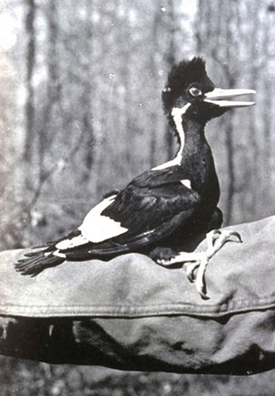
The distinctive, now-extinct ivory-billed woodpecker, origin of the phrase “Lord God Bird”. (Photo: satragon, Flickr CC BY-NC 2.0)
CURWOOD: So, one of the things you're write about this book is having a Lord God moment as a naturalist. Tell me what you mean by that, and your favorite Lord God moment.
WILSON: OK. Well, the Lord God moment comes from the southern name for Lord God bird. The Ivory-billed woodpecker never was very abundant, so that southerners, settling across the south, would occasionally see one. And when they first saw one - the second-biggest woodpecker in the world, you know, brilliantly colored - well, when they first saw the birds, people often said something like, "Lord, God, what is that?" And that spread enough so that many of them called it a Lord God bird.
And what can I say? I have had many Lord God moments, but mostly with ants. One such moment was in the tropical forest when I first saw a swarm of army ants up to millions in one colony marching as a broad front like a conquering army spreading through the forest floor capturing everything it could find and kill for their food and then settling back into a heavily guarded bivouac where they lived. That should be a Lord God moment for anybody to see that.
CURWOOD: Course, the Ivory-billed woodpecker is gone. You can't find it any more.
WILSON: It's gone. And the last one was seen, I think, in the early 1940s by a little boy who knew where a single Ivory-billed woodpecker would rest for a while, and he would go out to see it, and then one day that was gone, and all hunts for it have failed. I would have given anything to be able to see an Ivory-billed woodpecker.
CURWOOD: You have a name for the geologic epoch we may be creating here if we continue on the path of destroying habitat and causing species extinction. What is this name and tell me why you call it that?
WILSON: Well, you know, about the time of the name Anthropocene, the Age of Man, came in, I suggested that we use the term for this period that we dominate the world as the Eremozoic. Eremo means lonely. So Eremozoic means the Age of Loneliness. And for me, kind of the saddest part of all, there would be a heavy weight on the human soul if we really entered it, would be the Eremozoic, the Age of Loneliness where most of life on Earth that we evolved in, most of you and I are still living in, was gone forever.
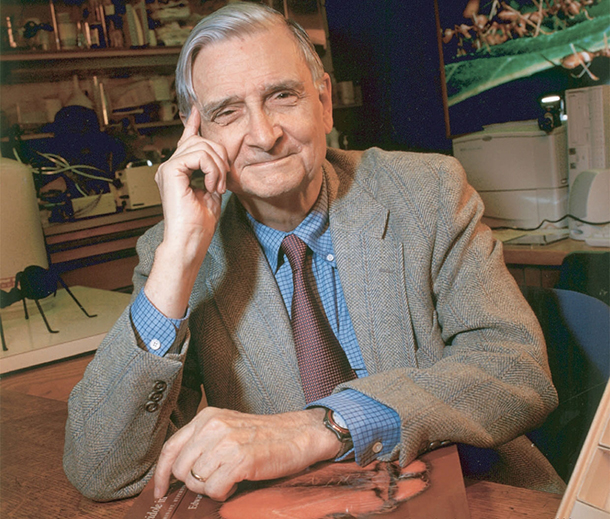
E.O. Wilson in his office at Harvard surrounded by images of the ants he studies as a myrmecologist. (Photo: Jim Harrison, Wikimedia Commons CC BY 2.5)
CURWOOD: And maybe our planet, our species, shouldn't try doing without the other species, huh?
WILSON: I think we shouldn't try that. I like to call it, “One Earth, one experiment.” We've only got one shot at this. Let's be careful.
[MUSIC: John Koutsouros, “Big Yellow Taxi” on Ladies Of the Canyon, written by Joni Mitchell, Reprise Records]
CURWOOD: I know that you're especially optimistic about the role that technology could play in conserving biological diversity? Why do you think the digital revolution is going to help nature rather than make things worse?
WILSON: You know, the first reaction to thinking about digital civilization we're moving into so dramatically right now is going to be bad for the natural environment. That's because we think about the digital revolution in the same terms that actually did exist leading up to it, but the digital revolution has qualities to it that are not shared, by any means, with the first primitive technological industrial revolution, and those qualities all point to a lessened size of what's called the ecological footprint. And everyone, I think, should know what the ecological footprint is because it's critical.
Ecological footprint is the amount of area – of space if you wish to make it three-dimensional - required by the average person to maintain for that one person all of the necessities of life. That ranges from food to water to shelter to entertainment to governance and on and on and on. And for most of the world it's one to 10 acres depending on the country. For America, it's much higher than anybody else, and it's not sustainable.
And why would I be optimistic that the digital world is going to shrink that? That is the nature of economic evolution, that people want and they will select if they have any choice, instruments and material goods that are smaller, consume less energy and material, need to be fixed less frequently and all of that means that the ecological footprint is destined to shrink. If we can now keep our hands off the natural areas in the world, if we can devise entertainment and fulfillment making use of all of the accoutrements and monuments of digital age and develop a conservation ethic, I envision a possible paradise for humanity by the 22nd century.
CURWOOD: Paradise for humanity by the 22nd century, and right now we're threatened by climate change, pollution, and loss of species at a precipitous rate?
WILSON: Well, I know. But now let's think about the United States over a comparable period. The development of the nation as a society from, say, 1800 to 1900, humans are making that rate of change, and I believe there's an inevitability of the shrinking of the ecological footprint, not because people know what it is and want to see it shrink, but because of the economic evolution that seems inevitable.
CURWOOD: E.O.Wilson’s new book is called “Half-Earth: Our Planet’s Fight for Life”. Thank you so much, Professor Wilson.
WILSON: Thank you for the opportunity.
Related links:
- E.O. Wilson Biodiversity Foundation
- Half-Earth: Our Planet’s Fight for Life
- About E.O. Wilson
[MUSIC: Sierra Eagleson, “Promise” on Every Kingdom, written by Ben Howard, Island Records]
We Are All In This Together
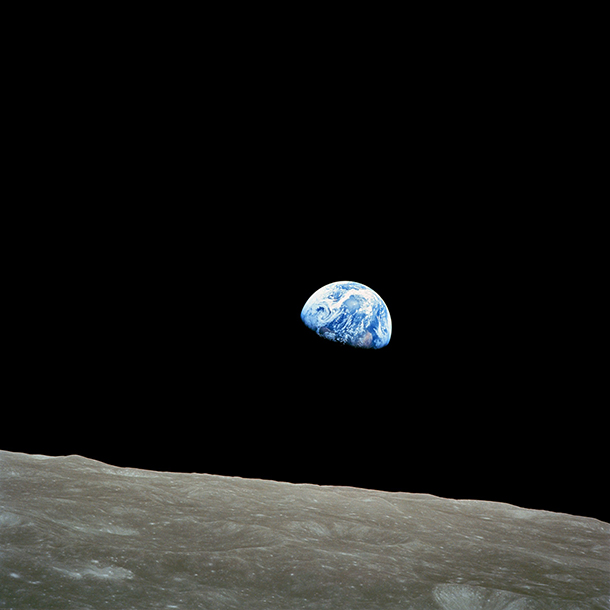
The influential “Earthrise” photo taken by Apollo 8 crewmember Bill Anders on December 24, 1968, while in the crew orbited the Moon. (Photo: NASA / Bill Anders)
CURWOOD: The other day I was speaking with famed astrophysicist Neil DeGrasse Tyson about his new book "Astrophysics for People in a Hurry" and we’ll air that discussion in the weeks ahead. But part of our conversation particularly struck me in this season of Earth Day.
Neil reminded me that the first Earth Day came little more than a year after we as a species first saw color pictures of our home from space...this exquisite blue marble teeming with life amid the endless darkness—where no political borders are visible. One indelible image from the Christmas 1968 mission of Apollo 8 was called Earthrise, the partially lit disk of the Earth rising above the cratered desolation of the moon, a riveting perspective of the tiny vessel we are aboard for our intergalactic journey as part of the Milky Way. That image reminded us that we are in this together, folks.
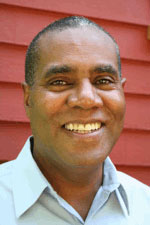
Living on Earth Host Steve Curwood. (Photo: Living on Earth)
No economic disaster or boom will change our orbit around the sun from this perfect distance where we are mostly warm enough to have liquid water and mostly cool enough to walk outside. And no change in the political order will duplicate the eons of evolution that have given us everything from roses to robins. And, by the way, not only is Earth just a speck in the cosmos, the planet’s habitable zone is just a thin crust a dozen or so miles thick, as thin as the shimmering skin of a large soap bubble. We celebrate Earth Day to remind ourselves that we have the power to pop that metaphorical bubble.
The nuclear warheads packed atop the missiles in just one of the Ohio class submarines in the sea off North Korea could send the planet into nuclear winter if they were all detonated. The unchecked rise of global warming gases could bring Earth’s atmosphere closer to that of Venus, now around 900 Fahrenheit degrees all of the time. And the reckless overuse of chemicals and unbridled destruction of habitat could drive us and the other creatures into oblivion.
Earth Day says we won’t. Earth Day says we love our home so much we refuse to let it come to harm, and we are grateful to honor Earth, the only planet we have.
Related links:
- More on the Apollo 8 Christmas Mission
- 1968 Apollo 8 crew reading from the Bible from space
- Earth Day website
[MUSIC: The Beatles, “FOR YOU BLUE” on Let It Be, written by George Harrison on Let it Be, Apple Records]
CURWOOD: Living on Earth is produced by the World Media Foundation. Our crew includes Naomi Arenberg, Bobby Bascomb, Savannah Christiansen, Jenni Doering, Noble Ingram, Jaime Kaiser, Don Lyman, Alex Metzger, Kit Norton, Helen Palmer, Adelaide Chen, and Jolanda Omari. Tom Tiger engineered our show, with help from Jake Rego. Alison Lirish Dean composed our themes.
You can hear us anytime at LOE.org - and like us, please, on our Facebook page - PRI’s Living on Earth. And we tweet from @LivingOnEarth. I'm Steve Curwood. Thanks for listening.
ANNOUNCER1: Funding for Living on Earth comes you, our listeners, and from the University of Massachusetts, Boston, in association with its School for the Environment, developing the next generation of environmental leaders. And from the Grantham Foundation for the protection of the environment, supporting strategic communications and collaboration in solving the world’s most pressing environmental problems. Support also comes from the Energy Foundation, serving the public interest by helping to build a strong, clean, energy economy, from Carl and Judy Ferenbach of Boston, Massachusetts and from SolarCity, America’s solar power provider. SolarCity is dedicated to revolutionizing the way energy is delivered by giving customers a renewable alternative to fossil fuels. Information at 888-997-1703. That’s 888-997-1703.
ANNOUNCER2: PRI. Public Radio International.
Living on Earth wants to hear from you!
Living on Earth
62 Calef Highway, Suite 212
Lee, NH 03861
Telephone: 617-287-4121
E-mail: comments@loe.org
Newsletter [Click here]
Donate to Living on Earth!
Living on Earth is an independent media program and relies entirely on contributions from listeners and institutions supporting public service. Please donate now to preserve an independent environmental voice.
NewsletterLiving on Earth offers a weekly delivery of the show's rundown to your mailbox. Sign up for our newsletter today!
 Sailors For The Sea: Be the change you want to sea.
Sailors For The Sea: Be the change you want to sea.
 The Grantham Foundation for the Protection of the Environment: Committed to protecting and improving the health of the global environment.
The Grantham Foundation for the Protection of the Environment: Committed to protecting and improving the health of the global environment.
 Contribute to Living on Earth and receive, as our gift to you, an archival print of one of Mark Seth Lender's extraordinary wildlife photographs. Follow the link to see Mark's current collection of photographs.
Contribute to Living on Earth and receive, as our gift to you, an archival print of one of Mark Seth Lender's extraordinary wildlife photographs. Follow the link to see Mark's current collection of photographs.
 Buy a signed copy of Mark Seth Lender's book Smeagull the Seagull & support Living on Earth
Buy a signed copy of Mark Seth Lender's book Smeagull the Seagull & support Living on Earth

